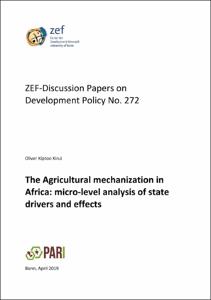The Agricultural mechanization in Africamicro-level analysis of state drivers and effects

The Agricultural mechanization in Africa
micro-level analysis of state drivers and effects

| dc.contributor.author | Kirui, Oliver Kiptoo | |
| dc.date.accessioned | 2022-06-02T07:33:02Z | |
| dc.date.available | 2022-06-02T07:33:02Z | |
| dc.date.issued | 04.2019 | |
| dc.identifier.uri | https://hdl.handle.net/20.500.11811/9840 | |
| dc.description.abstract | This paper examines the state, drivers and, consequently, the impacts of agricultural mechanization in eleven countries in Africa. Using representative multistage stratified household survey data and robust analytical approaches, findings show light hand-held tools and equipment remain the main type of machinery in most countries –about 48% of the sampled households have access to light machinery compared to 35% that haveaccess to animal-powered machinery, and only about 18% that use tractor-powered machinery. Significant drivers of agricultural mechanization include the size of the household, gender of the household head, participation in off-farm economic activities, distance to the input and output markets, farm size, land tenure, type of farming system, access to extension services, and use of fertilizer and pesticides. This study finds that after controlling for socio-economic, demographic, and regional determinants, agricultural mechanization, significantly increases the amount of cropland cultivated (extensification) and is also accompanied by input intensification especially in countries where land expansion is limited. We further find significant but mixed impact of agricultural mechanization on use of household and hired labor. Finally, agricultural mechanization significantly raises the productivity of maize and rice in all cases. These findings point to the importance of developing favorable arrangements that would avail mechanization to small and medium scale farmers. This would involve providing incentives for private sector to scale agricultural mechanization initiatives and targeting and engaging women farmers and the youth by investing in supportive infrastructure and training. | en |
| dc.format.extent | 60 | |
| dc.language.iso | eng | |
| dc.relation.ispartofseries | ZEF Discussion Papers on Development Policy ; No. 272 | |
| dc.rights | In Copyright | |
| dc.rights.uri | http://rightsstatements.org/vocab/InC/1.0/ | |
| dc.subject | Africa | |
| dc.subject | Employment | |
| dc.subject | Mechanization | |
| dc.subject | Agricultural production | |
| dc.subject.ddc | 300 Sozialwissenschaften, Soziologie, Anthropologie | |
| dc.subject.ddc | 333.7 Natürliche Ressourcen, Energie und Umwelt | |
| dc.subject.ddc | 360 Soziale Probleme, Sozialdienste, Versicherungen | |
| dc.subject.ddc | 500 Naturwissenschaften | |
| dc.subject.ddc | 620 Ingenieurwissenschaften und Maschinenbau | |
| dc.subject.ddc | 624 Ingenieurbau und Umwelttechnik | |
| dc.title | The Agricultural mechanization in Africa | |
| dc.title.alternative | micro-level analysis of state drivers and effects | |
| dc.type | Arbeitspapier | |
| dc.publisher.name | Center for Development Research (ZEF) | |
| dc.publisher.location | Bonn | |
| dc.rights.accessRights | openAccess | |
| dc.relation.doi | https://doi.org/10.2139/ssrn.3368103 | |
| ulbbn.pubtype | Zweitveröffentlichung |




